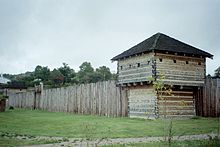- Cornstalk
-
Cornstalk (Shawnee: Hokoleskwa) (ca. 1720 - November 10, 1777) was a prominent leader of the Shawnee nation just prior to the American Revolution. His name, Hokoleskwa, translates loosely into "stalk of corn" in English, and is spelled Colesqua in some accounts. He was also know as Keigh-tugh-qua and Wynepuechsika.
Cornstalk opposed European settlement west of the Ohio River in his youth, but he later became an advocate of peace after the Battle of Point Pleasant. His murder by American militiamen at Fort Randolph during a diplomatic visit in November of 1777 outraged both American Indians and Virginians.
Contents
Biography
Early years
Historians believe he may have been born in present-day Pennsylvania, and moved to the Ohio Country, near present day Chillicothe, when the Shawnee fell back before expanding white settlement. Stories tell of Cornstalk's participation in the French and Indian War, though these are probably apocryphal. His alleged participation in Pontiac's Rebellion is also unverified, though he did take part in the peace negotiations.
Dunmore's War
Cornstalk played a central role in Dunmore's War of 1774. After the 1768 Treaty of Fort Stanwix, settlers and land speculators moved into the lands south of the Ohio River in present-day Kentucky. Although the Iroquois had agreed to cede the land, the Shawnee and others had not been present at the Fort Stanwix negotiations. They still claimed Kentucky as their hunting grounds. Clashes soon took place over this. Cornstalk tried unsuccessfully prevent escalation of the hostilities.
Attempting to block a Virginian invasion of the Ohio country, Cornstalk led a force of Shawnee and Mingo warriors at the Battle of Point Pleasant. His attack, although ferociously made, was beaten back by the Virginians. Cornstalk retreated and would reluctantly accept the Ohio River as the boundary of Shawnee lands in the Treaty of Camp Charlotte.
Cornstalk's commanding presence often made impressed American colonials. A Virginia officer wrote drom Camp Charlotte: "I have heard the first orators in Virginia, Patrick Henry and Richard Henry Lee, but never have I heard one whose powers of delivery surpassed those of Cornstalk on that occasion."
American Revolution
With the American Revolution began, Cornstalk worked to keep his people neutral. He represented the Shawnee at treaty councils at Fort Pitt in 1775 and 1776, the first Indian treaties ever negotiated by the United States. Many Shawnees nevertheless hoped to use British aid to reclaim their lands lost to the setlers. By the winter of 1776, the Shawnee were effectively divided into a neutral faction led by Cornstalk, and militant bands led by men such as Blue Jacket.
In the fall of 1777, Cornstalk made a diplomatic visit to Fort Randolph, an American fort at present-day Point Pleasant, seeking as always to maintain his faction's neutrality. Cornstalk was detained by the fort commander, who had decided on his own initiative to take hostage any Shawnees who fell into his hands. When, on November 10, an American militiaman from the fort was killed nearby by unknown Indians, angry soldiers brutally executed Cornstalk, his son Elinipsico, and two other Shawnees.
American political and military leaders were alarmed by the murder of Cornstalk; they believed he was their only hope of securing Shawnee neutrality. At the insistence of Patrick Henry, the governor of Virginia, Cornstalk’s killers (whom Henry called “vile assassins”) were eventually brought to trial, but since their fellow soldiers would not testify against them, all were acquitted.
Cornstalk was originally buried at Fort Randolph; in 1840 his grave was found and the remains moved to the Mason County Courthouse grounds; when in 1954 the courthouse was torn down he was reburied in Point Pleasant. Legends arose about his dying "curse" being the cause of misfortunes in the area (later supplanted by local "mothman" stories), though no contemporary historical source mentions any such utterance by Cornstalk.
References
- Downes, Randolph C. Council Fires on the Upper Ohio. University of Pittsburgh Press, 1940.
- Kellogg, Louise Phelps. "Cornstalk" in the Dictionary of American Biography, vol II. New York: Scribner, 1928.
- Sugden, John. "Cornstalk" in American National Biography. Oxford University Press, 1999.
- Roosevelt, Theodore. The winning of the West, Volume 1 G.P. Putnam's sons, 1889
External links
Categories:- 1720 births
- 1777 deaths
- American Revolutionary War executions
- Native Americans in the American Revolution
- Native American people of the Indian Wars
- Shawnee tribe
- Native American leaders
- Murdered Native American people
Wikimedia Foundation. 2010.


